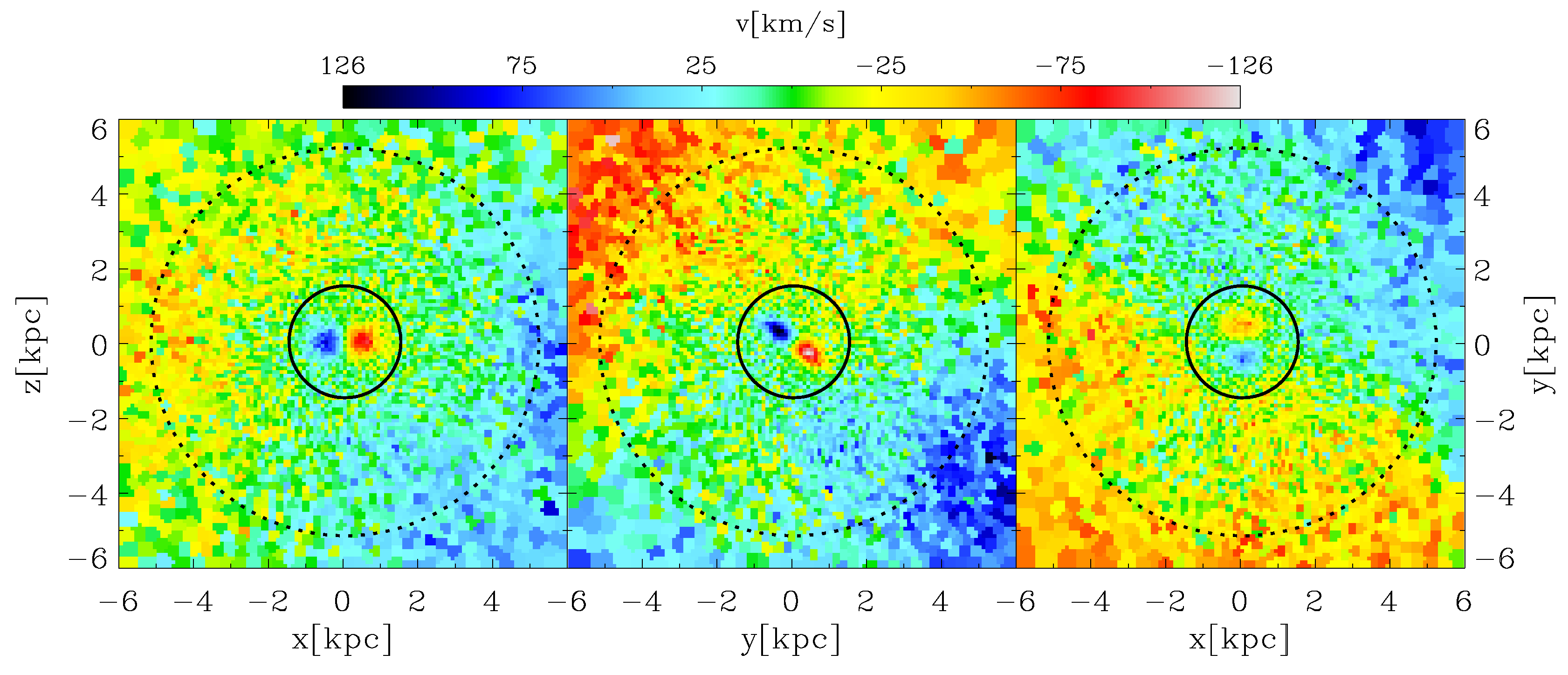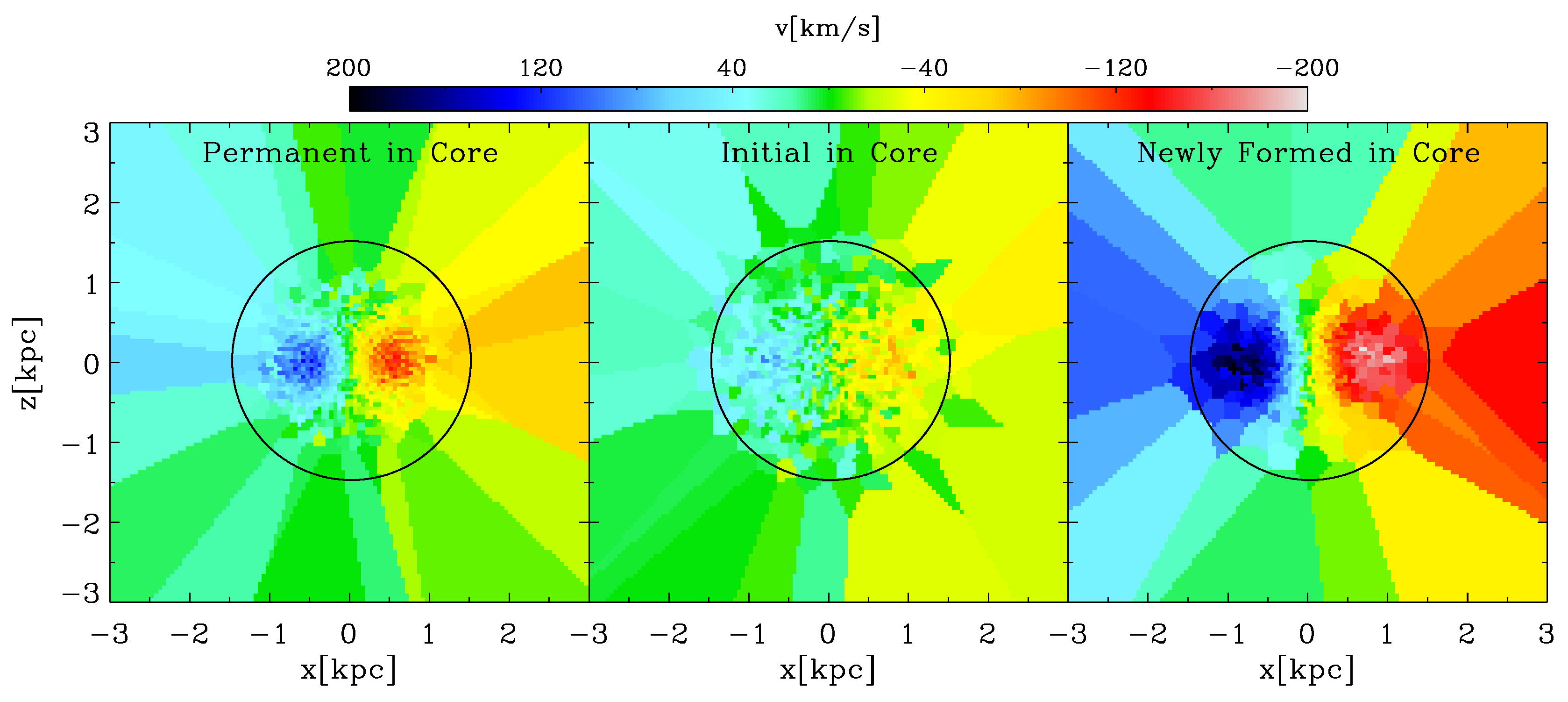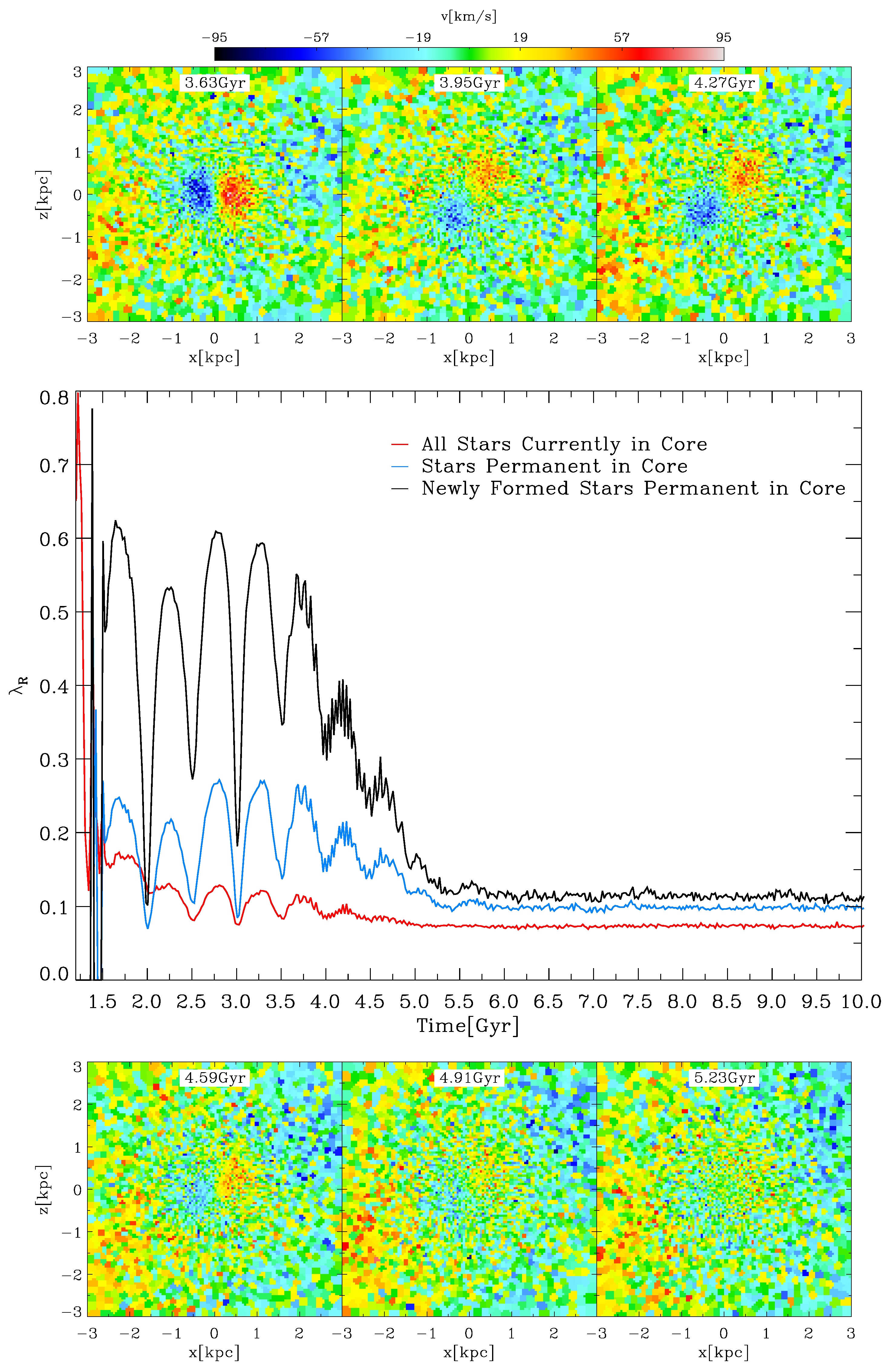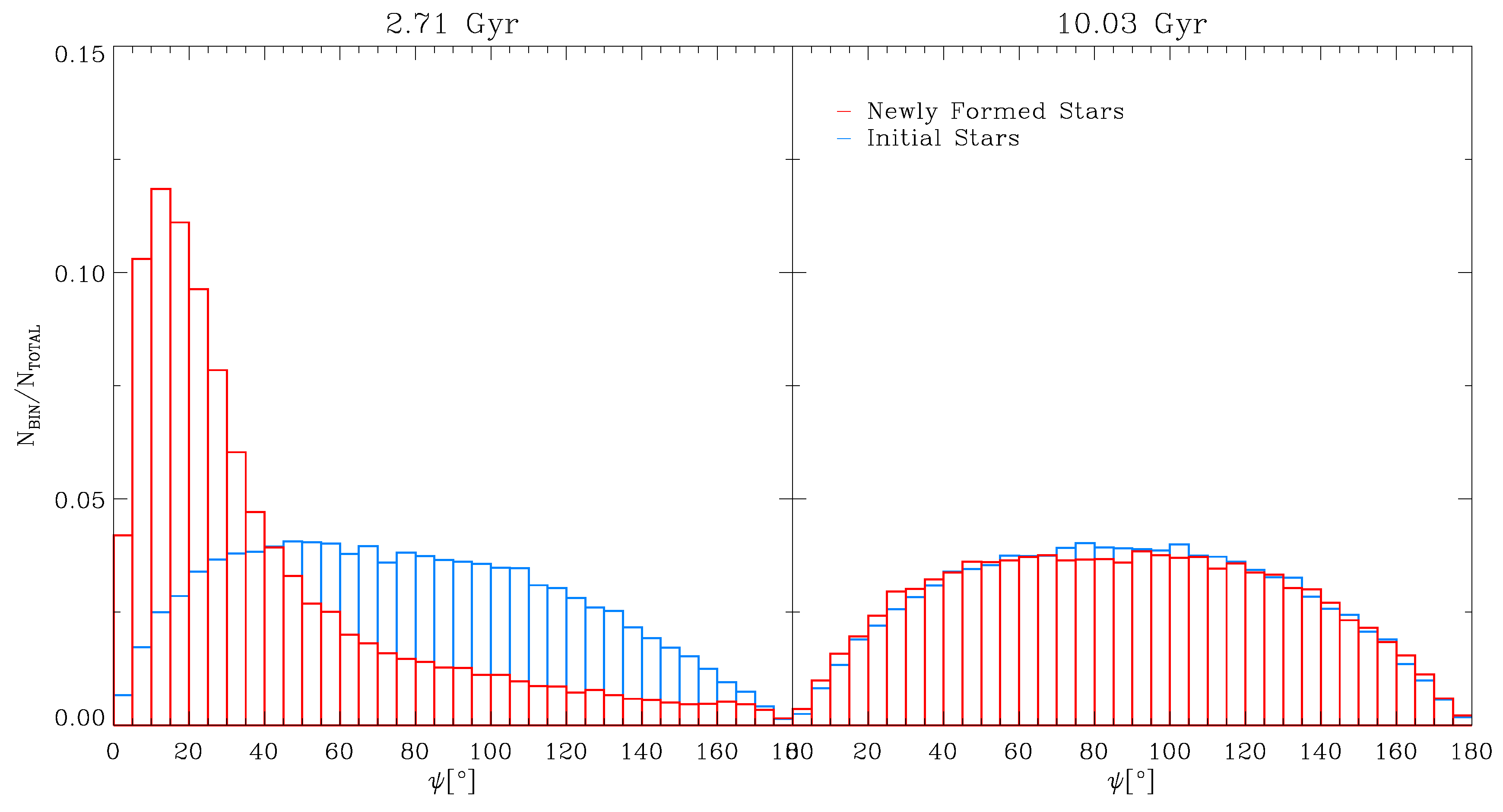3.1. Global Properties
Before investigating the kinematics of the KDC in detail, we have to determine the spatial extent of the KDC.
Figure 1 shows the LOSVD of the merger remnant projection onto the three coordinate planes after a simulation runtime of
that is
after the second encounter. As can clearly be seen, the merger remnant hosts a distinct central rotating feature that is present in all three projections (i.e., never seen face-on) and is clearly misaligned to the rotation of its surroundings. From the visual appearance of the LOSVD map, we conservatively estimate the radius of the KDC to be
, as shown by the solid black circle in
Figure 1. This corresponds roughly to a third of the stellar half-mass radius (
) of the remnant, which is illustrated by the black dashed line, and therefore much larger than the resolution limit. The half-mass radius is determined to be the radius of a three-dimensional sphere containing half of the total stellar mass centred on the galaxy center of mass.
Figure 2 displays the temporal evolution of the stellar (green) and gaseous (blue) mass within the core as well as the total SFR of the galaxy in black. The starting point in time is chosen to be directly before the second encounter to also capture the starburst triggered by the second encounter. This starburst lasts for approximately
, with a maximum SFR of
.
During this period, the stellar mass inside the KDC increases until it plateaus at . Afterwards, stays constant, excluding significant infall of stars. Consistently with a starburst, the amount of gas in the KDC decreases drastically by roughly one order of magnitude within this timeframe. The subsequent modest decrease of suggest ongoing star formation activity within the KDC, however at much lower rates.
3.2. Dissecting the KDC
To investigate the origin of the KDC signal in the LOSVD maps, we explore the contributions of stellar populations with different properties to the signal. We distinguish between stars that are set up in the initial conditions and stars that are produced during the runtime of the simulation, denoting them ’Initial Stars (IS)’ and ’Newly Formed Stars (NFS)’. The initial gas from which the NFS are formed is expected to form a disc in the centre during the merger due to its hydrodynamical nature and therefore generates a orbital configuration characteristic for discs. In contrast, the IS are only affected by violent relaxation and dynamical friction. Of course, the interplay between those processes and their efficiency is complex and depends on the parameters of the merger and hence cannot be predicted easily.
In addition, we split the stars inside the core into two groups, independently of whether they are IS or NFS: stellar particles that are permanently located within the KDC are classified as ’Permanent Core Stars (PCS)’, and stars which are localised only temporarily within the core denoted ’Temporary Core Stars (TCS)’. TCS are expected to move on highly elliptical orbits with apocenters beyond the KDC radius. For this purpose, we use a algorithm that iteratively removes particles that move outside of the KDC. At a runtime of , where the KDC is fully evolved, the algorithm selects all stellar particles within the KDC radius, traces this parent sample of stars to the consecutive snapshot, and removes the particles that leave the KDC radius from the sample. This procedure is reiterated for 24 subsequent snapshots until a runtime of . In this manner, the algorithm creates a sample of stellar particles that reside within the KDC for at least . This corresponds to approximately one characteristic orbital period within the KDC. By construction, this algorithm also disregards stellar particles falling into the KDC during the application of the procedure from the sample.
Figure 3 directly compares the visual contribution of the PCS and TCS to the rotational signature in the LOSVD map at
.
The left panel displays a zoom-in onto the KDC including all stellar particles in the line-of-sight. Velocity maps for the TCS and PCS are shown in the central and right panel, respectively. As can clearly be seen, the rotational signal is the net rotation induced by the PCS component overlaying the TCS component, which is dominated by random motion. The fact that the maximum velocities reached by the PCS is higher than those of the full stellar sample infers that the random moving component diminishes the signal as expected.
As we are interested in the origin of the KDC, we further separate the PCS into the two populations of IS and NFS. The result is displayed in
Figure 4: the left velocity map replicates the central panel of
Figure 3, while the central and right panels show the subdivision into IS and NFS, respectively. Comparing the central and right panels demonstrates that the KDC is dominated by the newly formed stars in agreement with the results from Hoffman et al., 2010 [
9]. The NFS component exhibits a peak velocity that is a roughly a factor of two higher than the peak velocity of the IS component. We reason that the minor rotation in the IS component might be generated by the drag caused by the fast rotating particles.
From our analysis we can conclude that the KDC signal in the merger remnant is generated mainly by stellar particles that permanently reside within the core and are formed during the merging process in situ. Therefore, the KDC seems to be in agreement with the younger more compact KDCs found observationally by McDermid et al., 2006 [
5].
3.3. Evolution of Stellar KDC Kinematics
To understand the evolution of the KDC, we investigate its kinematical behaviour over time with respect to the kinematical behaviour of the surrounding host galaxy. The previous section revealed that the actual KDC is composed of stellar particles formed in situ during the merger and hence might retain a fraction of the orbital angular momentum. To measure the orientation of the KDC, we calculate the total angular momentum of all stars located inside the KDC (
) for each snapshot, and calculate its angle to the three coordinate axes. In addition, the same angles are determined for the host galaxy to exclude a global mutual motion of the KDC and the galaxy within the simulated box. The temporal evolution of the angles is shown in the main panel of
Figure 5. The red, black and green curves represent the angles between the KDC and the coordinate axes, while the orange line marks the angle between the angular momentum of the host galaxy and the
z-axis.
The KDC angular momentum follows a completely unexpected behaviour: subsequent to a violent phase of relaxation lasting until
, the angles with respect to the coordinate axes reveal an oscillation of the KDC, which gets gradually dampened in the further evolution. The imprint of the oscillation is visible up to
, and the period of the oscillation is nearly equal for each axis and is determined to be
. As a two-dimensional visualisation, the upper and lower rows of
Figure 5 show the velocity field in the
x–
z plane projection at six points in times equally distributed over one oscillation period: from an initial alignment with the
x-axis at
, the KDC turns upwards by 90° at
. In the following snapshot, it gets more diffuse and almost disappears until it reverts to its initial configuration at
. The last panel shows the initiation of a new oscillation cycle indicated by the slight upturn.
Of course, the projected appearance in the velocity maps is strongly influenced by the rotation of the KDC around the other two coordinate axes. Furthermore, it is difficult to deduce the actual movement in three dimensions from the angles and the velocity maps. Therefore,
Figure 6 illustrates the direction of the angular momentum vector of the KDC in three-dimensional space at three points in time. The curves drawn on the coordinate planes visualise the projected track of the vector’s until its current position. In all three projections, the tracks describe slightly distorted circles that get smaller due to the damping of the oscillation until the angular momentum stabilises in direction.
From our analysis, we conclude that the total stellar angular momentum of the KDC performs a three-dimensional motion comparable to the precession of a gyroscope in a gravitational potential superimposed with a general tilt of the precession axis. From this, we infer that the kinematics of the KDC can be subdivided into an intrinsic rotation and a superimposed global figure rotation.
This result raises the questions of which mechanism generates this periodic, well-defined motion of the KDC and how it is damped. In the previous section we showed that the rotating component of the KDC comprises stars formed during the merger and that the intrinsic rotation is the result of the process, whereby gas condenses into a disc. We speculate that the precession is a residue of the orbital angular momentum of the merger event retained by the gaseous component.
3.4. Fading of the KDC
After revealing the origin and kinematics of the KDC in the previous sections, we now examine the temporal stability of the KDC with regard to its kinematical properties. The timescale on which the young compact KDCs are stable is still widely unknown since only numerical simulations with sufficient resolution can trace their evolution. In contrast, classical old KDCs are expected to be stable for up to since their stellar population is indistinguishable from their host galaxy.
One of the few investigations of KDC stability was conducted by McDermid et al., 2006 [
19] using a simulation based on SSP model spectra. They find that the KDC is fading due to the stellar evolution of the young KDC stars, as their luminosity-weighted contribution is diminished due to a increasing mass-to-light ratio. Following this argument, the KDC is still present, however forced to the background of the velocity field.
As shown in the previous section, our analysis provides a reasonable dissection of the core into its rotating and dispersion dominated component by differentiating the IS and NFS components confirmed by their visual appearance in the LOSVD maps.
A sequence of LOSVD maps in various decisive steps of the KDC evolution considering all stars in the line-of-sight from
to
are shown in the upper and lower rows of
Figure 7. The projection plane is held constant in all panels. After a runtime of
, the KDC is still clearly visible performing a precession in the two following snapshots. Between
and
, the KDC signal gradually gets weaker until it vanishes almost completely. By testing different projections, we confirmed that this fading is real and not just due to a precession of the core, as in the previous time steps where a weakening of the KDC signal could be detected in one projection, while it strengthened in another projection. Up to the full time of the simulation, the KDC does not build up again in any projection, clearly indicating that the KDC was dissolved. Hence, we conclude that the KDC is fading on a timescale of
.
In order to quantify the rotational support of the stellar populations of the KDC, we calculate the
parameter for the core, which is given by
where the summation runs over each pixel within the chosen aperture.
,
,
and
are the flux, projected distance to the galaxy centre, mean stellar velocity and velocity dispersion of the
ith pixel, respectively (Emsellem et al., 2007 [
20]). For simulations, the fluxes are replaced by stellar masses as we do not have luminosities, while assuming a constant mass-to-light ratio within each galaxy.
is a measure of the ratio of random to ordered motion. Furthermore,
is an observationally accessible quantity, albeit sensitive to projection effects.
The temporal evolution of
in the core region, measured in the
x–
z plane and considering different populations of stars, is displayed in the main panel of
Figure 7. The red curve shows
for all stellar particles within the KDC at each time step, while blue and black curves represent the PCS and newly formed PCS population, respectively. A common feature of all three populations is an imprinted oscillation, reflecting the projection effects induced by the precession of the KDC revealed in the previous section.
Comparing the mean level of for the three populations, the red and blue curves exhibit significantly less rotational support than the black curve. For the total population, this is due to the included, highly dispersive TCS component. In the case of the PCS, we showed that the IS subcomponent gets partly dragged into rotation, however, at a factor of two slower than the NFS subcomponent. Thus, the dispersion within the PCS is still rather large and explains the lower values of the blue curve.
The newly formed PCS component shows -values as high as , which is a clearly rotation-dominated signal. However, due to the precession of the core, it can reach values as low as when the core precesses out of the x–z-plane, extinguishing any rotational signal. Between and , we find a gradual decrease to , which is clearly in the slow rotating regime populated by non-rotating early-type galaxies, on a timescale of . This is in agreement with the fading timescale inferred from the inspection of the LOSVD maps.
To further constrain the fading of the KDC, we take full advantage of the three-dimensional information from the simulation. A useful method to determine the degree of ordered rotation within a system of particles is to calculate the distribution of the angles between the angular momentum of each particle and the total angular momentum vector of the complete system. For a rotating system, the distribution of these angles is expected to feature a peak at small angles, while a completely dispersion-dominated system is expected to show a random distribution. The distribution of these angles at two points in time for the PCS is displayed in
Figure 8 separated for the IS (blue) and NFS (red) populations. The highlighted times are chosen such that, at the earlier point (
), the KDC is fully developed, while, at the later time (
), the KDC is completely dispersed.
The angle distributions shown in
Figure 8 conclusively confirm the kinematical difference between the IS and NFS population already found in
Section 3.2. Already at
, the IS component shows a nearly randomised distribution of angles, indicating a dispersion dominated system. In contrast, the distribution for the NFS population completely changes its shape over the period of
. At
, the distribution features a clear peak at low angles, indicating ordered rotation in the system. At
, the alignment disappears entirely, evolving into a purely random distribution. Therefore, we conclude that the population of NFS generating the KDC signal at earlier times disperses in its further evolution. This is most likely caused by the interaction between the PCS and the dispersion dominated TCS component. We conclude that, depending on the mass ratio between the two populations, gravitational mixing drives the combined system towards a homogeneous distribution in phase space, dissolving the KDC.













